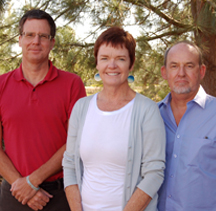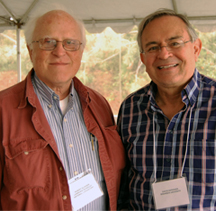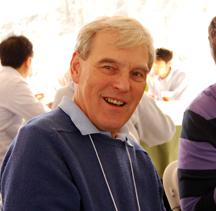TSRI Hosts Burgeoning Electron Microscopy Workshop
By Cindy Brauer
Established as a hands-on teaching conference in 2003, a biennial workshop on molecular electron microscopy at The Scripps Research Institute (TSRI) has evolved into an intense, high-level forum on cutting-edge issues, distinguished by a spirit of generosity and collegiality among its expert lecturers and participants.
Now considered one of the most important and useful meetings in the rapidly maturing field of molecular electron microscopy, each six-day workshop has been organized by Professors Bridget Carragher, Clint Potter and Ron Milligan under the auspices of the National Resource for Automated Molecular Microscopy (NRAMM).
“The workshop’s stature is also reflected by the leaders in the field who participate each year and enthusiastically encourage us to keep holding it,” said Carragher.
Held once again at TRSI’s Center for Integrated Molecular Biosciences, the November 2012 event drew worldwide participation from as far away as Singapore, Australia, China, Switzerland, Germany and England, as well as across the United States.
This year’s 140 workshop attendees, who included senior and junior scientists, graduate students and postdoctoral fellows, participated in more than 30 lectures, presentations, and discussions on current technical and computational challenges and potential solutions in the field. The meeting’s focus was improving experimental and computational procedures and developing data validation methods.
Workshop Follows Field Development
Modern electron microscopy dates back 45 years, and its use for the determination of molecular structures has become mainstream. The technology—in its various forms—provides quality images of the “molecular machinery” within cells, allowing scientists to explore how that machinery functions. As the electron microscopy field has matured, so has the NRAMM workshop.
“When we started 10 years ago, the workshop was aimed primarily at people just entering the field,” said Milligan. “We taught how to prepare specimens for electron microscopy examination, take images and computationally process the images. Today we’re tackling the very difficult issues we currently encounter in the field.”
“The pool of scientists in this field is now self-sufficient and beyond the basic training issues,” said Bob Glaeser, professor emeritus of biochemistry and molecular biology at the University of California, Berkeley, and a founder of modern electron microscopy who was guest lecturer at the conference. “Now the workshop centers on advanced knowledge and issues. The standards of discussion are high, and it’s open to all.”
David DeRosier, professor emeritus of life sciences at Brandeis University and another leading figure in the field emphasizes the workshop still holds great value for young scientists: ““Young people meet with other young people to talk about their projects and share ideas, including research obstacles they’ve run into.” DeRosier has presented NRAMM workshop lectures for several years.
Technology Expense Presents Challenges
Among the challenges discussed during this year’s workshop were the advances in microscopic technology making the field easier but more expensive to investigate, said Richard Henderson, group leader (and former director) at the MRC Laboratory of Molecular Biology in Cambridge, UK. Henderson, like DeRosier and Glaeser, is a founding figure in the field and a workshop guest lecturer. “Because of the increasing expense of technology, in the future there may be national centers for this kind of science,” said Henderson. “And Scripps should be one of them.”
Organizers Milligan, Potter and Carragher built into the workshop’s busy agenda ample free time for small group interactions. “It was energizing to have all these colleagues exchanging ideas,” said Potter.
A hallmark of the gathering, noted by organizers, lecturers and attendees, was the unselfish sharing of ideas and projects, including unpublished data. “There’s a freedom from ego and the feeling that you must impress competitors and peers at this workshop,” said Glaeser. “This workshop is really special in its collegiality and enjoyment what others are doing in the field.”
The workshop was supported by the National Institute of General Medical Sciences. Additional sponsors included TSRI, the Agouron Institute, FEI Company, Gatan, Direct Electron, Fischione Instruments and Protochips.
Send comments to: press[at]scripps.edu
















